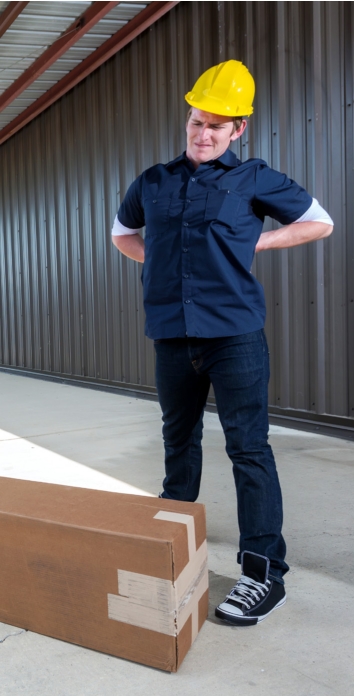OH, MY ACHING BACK!

Many factors increase risk for low back pain
At one time or another, low back pain will affect more than 80 percent of Americans with varying degree of pain. The duration of pain can be sudden, sharp pain or a slow constant dull ache. The pain might be felt in the lower back and/or in the legs and feet. There are many factors that can increase one’s risk for low back pain including:
• Age. The older you are, the more likely you are to experience back pain. Often initial onset on back pain is experienced in one’s 40s and 50s.
• Poor Fitness Level. The less physically active you are, the greater chance there is to experience back pain due to decrease muscle use.
• Being Overweight. Additional weight can cause stress and strain on your back, which ultimately leads to back pain.
• Heredity. Some causes of back pain, such as ankylosing spondylitis, a form of arthritis that effects the spine, can have a genetic component.
• Occupation. If your job requires that you push, pull, lift or twist your spine, you may be at increased risk for back pain. Further, if you sit at a desk for most of the day, failure to sit up straight can cause increased tension to your back.
• Smoking. There is a chance that your body may not be able to get proper nutrients to your back if you smoke and smokers are typically slower to heal.
• Other Diseases. Arthritis, cancer, fibromyalgia, endometriosis are just some of the diseases that can cause back pain.
The common causes of low back pain are nerve and muscular problems, degenerative disc disease and arthritis. It is important that you see a physician for a proper diagnosis and course of treatment if you experience:
• Numbness or tingling in your back, legs or feet;
• Severe pain that does not improve with rest;
• Pain after a sudden fall or injury;
• Pain in addition to any of these symptoms
• Trouble urinating
• Fever
• Unintentional weight loss.
At your appointment with your spine surgeon, he/she will take a general medical history and may order certain tests, such as: X-rays, magnetic resonance imaging, computed tomography and/or blood tests.
Depending on your diagnosis, you and your spine surgeon will determine the best treatment options. There are a number of non-invasive or non-surgical approaches patients can consider under their physicians care:
Pharmacotherapy. There are many nonnarcotic medicine(s) that successfully treat and minimize the pain caused from back injuries and conditions allowing the patient the ability to heal from an injury that does not require surgery.
Physical Therapy. Physical therapists can perform musculoskeletal evaluations on patients according to diagnosis and physicians orders. The evaluation may include an assessment of the patient’s posture, range of motion, muscle strength, coordination, balance and spinal joint restrictions. Physical therapy treatment may be provided based on the initial assessment and physician orders. Treatment may include:
1. Manual therapy to reduce joint restriction and musculoskeletal dysfunction.
2. Exercise instruction for appropriate diagnosis or post-operative condition.
3. Communication with professionals in outlying areas to facilitate appropriate rehabilitation progression.
Epidural Steroid Injections. The term epidural steroid injection refers to the injection of corticosteroids into the epidural space of the vertebral column as a means of treating pain caused by irritation of the spinal nerves. The chief effect of a pain management injection is to reduce pain, but the effect is not long-lasting and differs from person to person. Most patients will receive good relief ranging from several weeks to up to three months after injection.
Selective Nerve Root Blocks. A selective nerve root block injection is performed to determine if a specific spinal nerve root is the source of pain and also to reduce any inflammation located around the nerve root. Under fluoroscopy, the physician locates a specific spinal nerve root and injects medication through the skin into the area adjacent to the nerve root bathing the inflamed area. The procedure takes approximately 30 minutes to an hour and the expected outcome is relief of leg and back pain.
Facet Rhizotomy. Facet rhizotomy has been successful in relieving chronic pain arising from abnormalities of the facet joint. This procedure is an outpatient procedure for patients whose pain is not related to disc herniation. The selection process for identifying potential candidates for this procedure requires that the patient has experienced successful selective nerve root blocks. A local anesthetic numbs the injection site, then an X-ray machine guides the placement of the needle. Once the needle is injected, a very mild electrical current is used to stimulate the nerve and verify its exact location and a slight tingling or pressure may be experienced. The needle is then heated to deaden the sensory nerves. An improvement in pain should be seen within a few days, and continued improvement should be expected over the next several weeks.
It is important to remember that there are options both surgical and non-surgical to discuss with your doctor. I want my patients actively involved in the decisions of their health care. It is important to discuss outcomes and expectations of various interventions. Ultimately, I believe in treating the “whole” patient–physically, mentally and spiritually; it is vital to healthy outcomes and recoveries.
Dr. Pierce Nunley is the medical director of the Spine Institute of Louisiana and serves on the Board of Managers for Specialists Hospital Shreveport. He lectures internationally, holds many patents, is a member of numerous boards and recipient of multiple prestigious awards in the field of spine surgery and research. In 2016, Nunley was named as one of the Top 315 Spine Surgeons to Know by Becker’s Spine Review.
